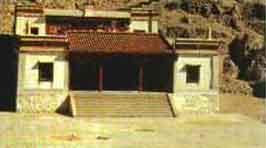Source: Inner Mongolia News
07-24-2007 13:54
 |
Agui Temple is situated in Erlang Mountain in Hatengsumu, Dengkou County. It was originally built in 1803. The temple is a typical Tibetan style building; it has a Hall ofSakyamuni and 981 wing halls. With an area of over 1000 mu, it isthe largest Tibetan Buddhist temple in Northwest China.
Agui is the Mongolian word for "cave". There are five natural caves in the barrancas surrounding the temple, namely the Agui Cave, Shengle Jingang Cave, Park Main Cave, Water-curtain Cave and the Buddha Protection Cave. Agui Templeis famous for its oddity, loneliness, height and steepness. There's a divine fountain with a daily gushing volume of 110 tons,with the waters used for drinking and bathing. Such desert plants as Caragana microphylla Lam, Opuntia vulgaris Mill and Haloxyon ammodendron are growing onthe alluvial fans in front of the mountain, and the fans are included in natural forest protection area by the government of the autonomous region. Such places of interests as the Yinshan rock painting group, Great Wall of the Qin Dynasty, ancient tomb of the Han Dynasty, Jilusai, Hongyang Cave and Fairy Pool are found along the foot of the mountain.
Editor:Chen Ge
